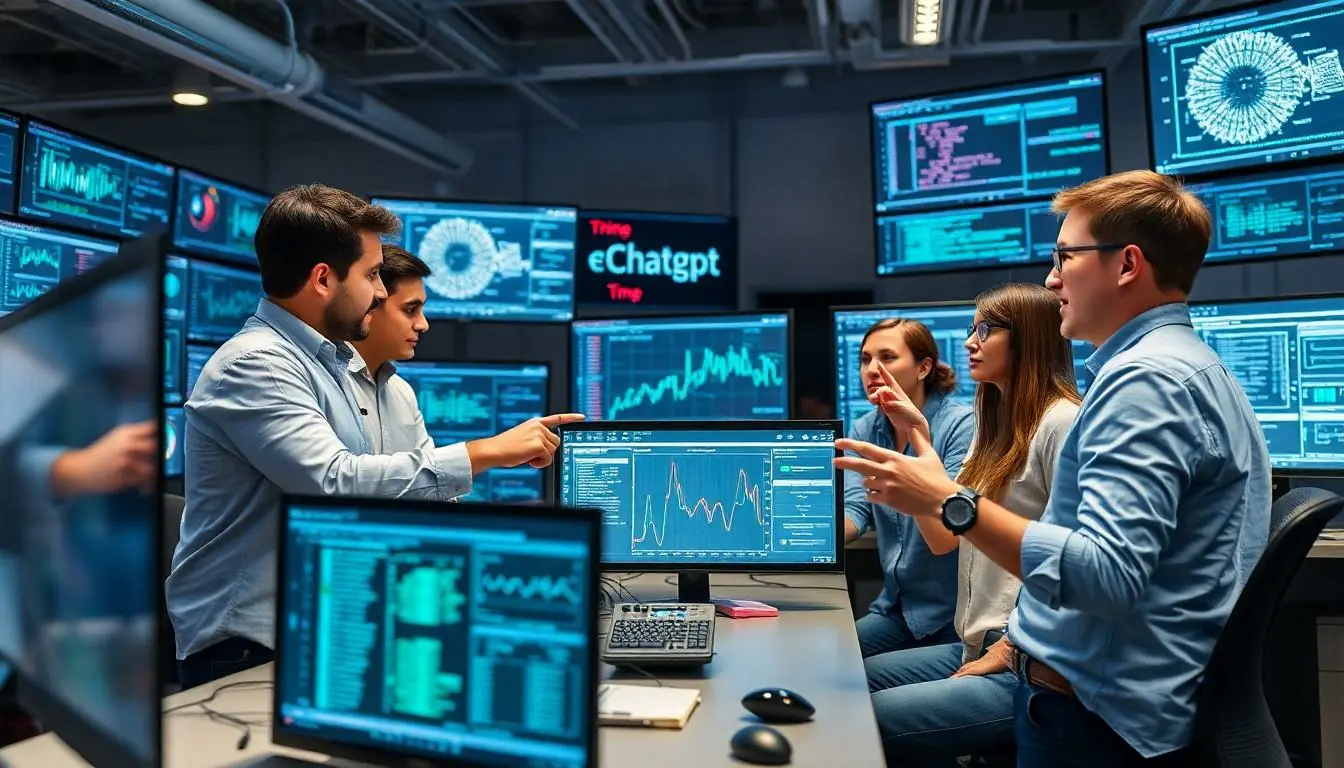In the world of AI, training a model like ChatGPT is no walk in the park. Picture a marathon runner preparing for the big race—endless hours of practice, a few existential crises, and maybe a snack or two along the way. So, just how long did it take to whip ChatGPT into shape? Spoiler alert: it’s not a quick coffee break!
Table of Contents
ToggleOverview of ChatGPT Training
Training ChatGPT involves multiple stages, requiring both time and computational resources. Initial phases focus on gathering large datasets containing diverse internet text. Researchers aim to provide ChatGPT with a wide-ranging understanding of language patterns and contexts.
The pre-training process typically utilizes large-scale machine learning algorithms. This stage can take weeks or even months, depending on the computational power available. Using thousands of GPUs, engineers can accelerate the training process while managing extensive datasets.
Fine-tuning follows pre-training, which involves refining the model based on more specific datasets. This stage ensures that ChatGPT aligns closely with desired conversational dynamics and responsiveness. Fine-tuning generally requires an additional few weeks to achieve optimal performance.
During training, various challenges arise. Tackling issues like bias and inconsistency in responses remains paramount. Developers continually monitor and adjust the model’s performance to ensure it meets user needs effectively.
Metrics for evaluating performance are essential throughout the training process. Regular assessments help in identifying areas for improvement and fine-tuning approaches. Collecting feedback from users further enhances the training cycle, making ChatGPT more adept over time.
Overall, the training of ChatGPT reflects a commitment to creating a highly functional AI model. Resources devoted to this extensive process contribute significantly to its capabilities, ensuring it can understand and generate human-like text effectively.
Training Duration Breakdown
Training ChatGPT involves several critical phases, each requiring significant time and resources to achieve optimal performance.
Initial Development Phases
Researchers begin the process by collecting extensive datasets that encompass diverse internet text. This foundational step provides the model with a comprehensive understanding of language patterns and contexts. Pre-training utilizes large-scale machine learning algorithms along with thousands of GPUs, significantly speeding up computations. Weeks or months may pass before the pre-training phase completes, depending on the computational power available. Getting this stage right sets the stage for success in future phases.
Fine-Tuning Stages
Fine-tuning follows pre-training, focusing on refining the model with specific datasets tailored to improve conversational skills. Additional weeks are typically dedicated to this phase, where developers work to enhance responsiveness, ensuring that ChatGPT aligns with user expectations. Challenges such as bias and inconsistencies demand careful monitoring and adjustment. Performance metrics are consistently evaluated during this time, guiding iterative improvements based on user feedback. As a result, ChatGPT becomes more adept at generating human-like text, reflecting a commitment to excellence in AI development.
Factors Affecting Training Time
Training duration for ChatGPT varies based on multiple elements that contribute to its overall efficiency and effectiveness.
Data Size and Quality
Data size and quality significantly influence training duration. A robust dataset enhances language understanding and model performance. Gathering extensive amounts of diverse internet text ensures the model learns various contexts and patterns. Larger datasets typically require more time for processing, increasing the overall training length. Quality also plays a crucial role; high-quality, accurately labeled data reduces errors and improves learning efficiency. Employing imperfect datasets often leads to longer training times as the model struggles to understand nuances.
Hardware and Infrastructure
Hardware and infrastructure directly impact the speed of training. Utilizing advanced GPUs or TPUs accelerates computation, decreasing time spent on training phases. A high-performance computing cluster facilitates quicker data processing and model updates. Resource allocation, such as memory and storage, affects training speed. Optimizing infrastructure can enhance efficiency and performance. Inefficient hardware setups slow down the training process, leading to extended timelines. Balancing hardware capabilities with model requirements ensures a more streamlined training experience.
Comparing ChatGPT Training with Other Models
ChatGPT’s training process stands out when compared to other AI models. Different models exhibit varying training times based on architecture and complexity. For instance, BERT, developed by Google, also involves extensive pre-training and fine-tuning but has a shorter overall training duration due to its design.
The transformer architecture used in ChatGPT allows for efficient processing of large datasets. This efficiency leads to weeks of pre-training, while models like OpenAI’s GPT-2 require similar time but differ in scale and objectives. With hundreds of gigabytes of text, ChatGPT needs ample computational resources, often relying on thousands of GPUs to manage workloads effectively.
Fine-tuning times also vary. ChatGPT’s fine-tuning phase, which focuses on enhancing conversational capabilities, typically spans several weeks, similar to other transformer models. Techniques used in managing bias and improving accuracy in responses often reflect broader trends in AI model training, emphasizing the necessity of constant adjustments.
Data quality and size impact the training process significantly across all models. ChatGPT benefits from a rich dataset, with hundreds of millions of examples contributing to its linguistic understanding. In contrast, smaller models might achieve results quicker but often lack depth and robustness in language comprehension.
Infrastructure plays a critical role in this context. With the advancement of hardware such as GPUs and TPUs, training durations can decrease dramatically. Models utilizing cutting-edge technology often see improved efficiency, directly affecting how quickly they can adapt and learn from their datasets.
This analysis highlights how ChatGPT’s training duration aligns with or diverges from other models, demonstrating its meticulous approach to achieving high-quality AI performance.
The training of ChatGPT underscores the intricate balance between time and resource investment in developing advanced AI models. This extensive process involves meticulous planning and execution to ensure the model not only understands language but also responds effectively in conversations.
As technology continues to evolve the commitment to refining AI capabilities remains paramount. The dedication shown in ChatGPT’s training journey highlights the ongoing pursuit of excellence in natural language processing. With each iteration the potential for more sophisticated interactions grows, paving the way for future advancements in AI communication.



